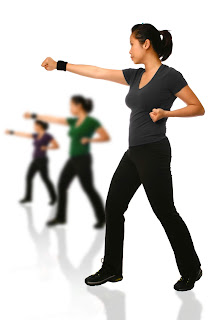Self Defense
Self-defense (self-defence in some varieties of English) is a countermeasure that involves defending the health and well-being of oneself from harm. The use of the right of self-defense as a legal justification for the use of force in times of danger is available in many jurisdictions.
Physical self-defense is the use of physical force to counter an immediate threat of violence. Such force can be either armed or unarmed. In either case, the chances of success depend on a large number of parameters, related to the severity of the threat on one hand, but also on the mental and physical preparedness of the defender.
Many styles of martial arts are practiced for self-defense or include self-defense techniques. Some styles train primarily for self-defense, while other martial or combat sports can be effectively applied for self-defense. Some martial arts train how to escape from a knife or gun situation, or how to break away from a punch, while others train how to attack. To provide more practical self-defense, many modern martial arts schools now use a combination of martial arts styles and techniques, and will often customize self-defense training to suit individual participants.
Further information: Non-lethal weapon and Melee weapon
A wide variety of weapons can be used for self-defense. The most suitable depends on the threat presented, the victim or victims, and the experience of the defender. Legal restrictions also greatly influence self-defence options.
In many cases there are also legal restrictions. While in some jurisdictions firearms may be carried openly or concealed expressly for this purpose, many jurisdictions have tight restrictions on who can own firearms, and what types they can own. Knives, especially those categorized as switchblades may also be controlled, as may batons, pepper spray and personal stun guns and Tasers - although some may be legal to carry with a license or for certain professions.
Non-injurious water-based self-defense indelible dye-marker sprays, or ID-marker or DNA-marker sprays linking a suspect to a crime scene, would in most places be legal to own and carry.
Everyday objects, such as flashlights, baseball bats, newspapers, keyrings with keys, kitchen utensils and other tools, and hair spray aerosol cans in combination with a lighter, can also be used as improvised weapons for self-defense. Tie-wraps double as an effective restraint. Weapons such as the Kubotan (pocket stick) have been built for ease of carry and to resemble everyday objects.Ballpoint pen knives, swordsticks, cane guns and modified umbrellas are similar categories of concealed self-defense weapons that serve a dual purpose.
Physical self-defense is the use of physical force to counter an immediate threat of violence. Such force can be either armed or unarmed. In either case, the chances of success depend on a large number of parameters, related to the severity of the threat on one hand, but also on the mental and physical preparedness of the defender.
Many styles of martial arts are practiced for self-defense or include self-defense techniques. Some styles train primarily for self-defense, while other martial or combat sports can be effectively applied for self-defense. Some martial arts train how to escape from a knife or gun situation, or how to break away from a punch, while others train how to attack. To provide more practical self-defense, many modern martial arts schools now use a combination of martial arts styles and techniques, and will often customize self-defense training to suit individual participants.
Further information: Non-lethal weapon and Melee weapon
A wide variety of weapons can be used for self-defense. The most suitable depends on the threat presented, the victim or victims, and the experience of the defender. Legal restrictions also greatly influence self-defence options.
In many cases there are also legal restrictions. While in some jurisdictions firearms may be carried openly or concealed expressly for this purpose, many jurisdictions have tight restrictions on who can own firearms, and what types they can own. Knives, especially those categorized as switchblades may also be controlled, as may batons, pepper spray and personal stun guns and Tasers - although some may be legal to carry with a license or for certain professions.
Non-injurious water-based self-defense indelible dye-marker sprays, or ID-marker or DNA-marker sprays linking a suspect to a crime scene, would in most places be legal to own and carry.
Everyday objects, such as flashlights, baseball bats, newspapers, keyrings with keys, kitchen utensils and other tools, and hair spray aerosol cans in combination with a lighter, can also be used as improvised weapons for self-defense. Tie-wraps double as an effective restraint. Weapons such as the Kubotan (pocket stick) have been built for ease of carry and to resemble everyday objects.Ballpoint pen knives, swordsticks, cane guns and modified umbrellas are similar categories of concealed self-defense weapons that serve a dual purpose.


Comments
Post a Comment